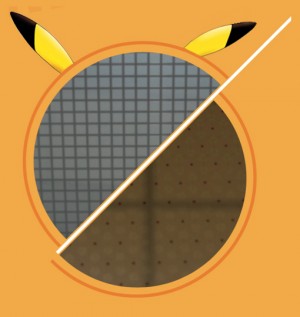
Silicon detectors like these two different kinds of wafers, combined in an artwork for the AIDA2020 workshop poster, are versatile and popular.
It’s not the catchiest of titles – “Energy and time management with high-granularity silicon devices”. But the subject matter is rather catchy, both literally and figuratively: it’s not only about catching particles; it also caught on from one project to another. A recent workshop on silicon detector technology held during the first AIDA-2020 meeting in Hamburg in June brought together experts and users of the technology from a wide range of projects – including ILC and LHC detectors.
Silicon detectors are not only the components in your digital camera that detect light and make it possible to reproduce an image, they also play a crucial role in particle detectors, both present and future. Historically rather used for tracking detectors they’re about to find their way into calorimeters; take for example the CALICE collaboration that among others carries out the R&D for a silicon-based calorimeter with an active area of 2500 square metres aimed at the ILD detector — one of the two detector concepts for the ILC. This silicon calorimeter would comprise around a thousand times more cells than typical calorimeters today. The R&D is driven by the concept of particle flow, a complete reconstruction of every particle from a collision. Both concept and technology are so promising that the CMS collaboration, a group of some 3000 scientists who plan, build, run and use the CMS detector at the LHC at CERN, has decided to build their calorimeter end cap with silicon as well. It will cover an area of 600 square metres. At a smaller scale a similar detector is also under study for LHC’s ATLAS upgrade, where it would be positioned in front of the existing end cap calorimeter.
Some 80 calorimeter and silicon tracking experts from a variety of projects and labs as well as newcomers to the field attended the workshop, which started on 13 June, the day before the first annual AIDA-2020 meeting kicked off.
“AIDA-2020 provides the perfect platform for exchange,” says Roman Pöschl from CNRS (at LAL, Orsay, France) who has organised the workshop together with Abe Seiden (UCSC) and Marcello Mannelli (CERN) on invitation of the AIDA-2020 management. “We meet as experts looking for the best technology without being bound to our respective projects and collaborations. And we managed to get everybody around one table.”
Silicon is key for precision measurements in an environment with large numbers particles because it allows for a high degree of pixelisation. Therefore tangled jets of particles can be neatly separated into their individual components including information about their respective energies, allowing for very exact information about what went on when two particles collided. For LHC detectors, it will also have to provide an excellent time resolution to cope with the large pile-up, multiple interactions during one bunch crossing. The goal is to have a time resolution of 10 picoseconds and developers are busy putting this requirement to the test.
“We don’t need this challenging time resolution for ILC detectors because the beam characteristics are so different between LHC and ILC,” says Pöschl, “but who knows, maybe we can use the information as well? We are certainly looking at the options.” Using the CALICE silicon technology in CMS will be a “reality test”, he says. And if you think that high-granularity silicon devices with precise time measurement are a challenge, think again – the participants have already started discussing ultra-high-granularity concepts for ultra-futuristic particle physics projects. Another factor 1000 is at stake.

Recent Comments